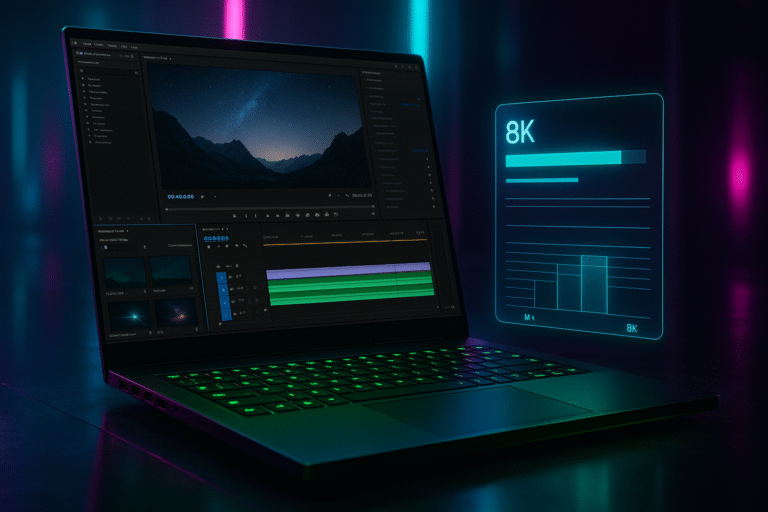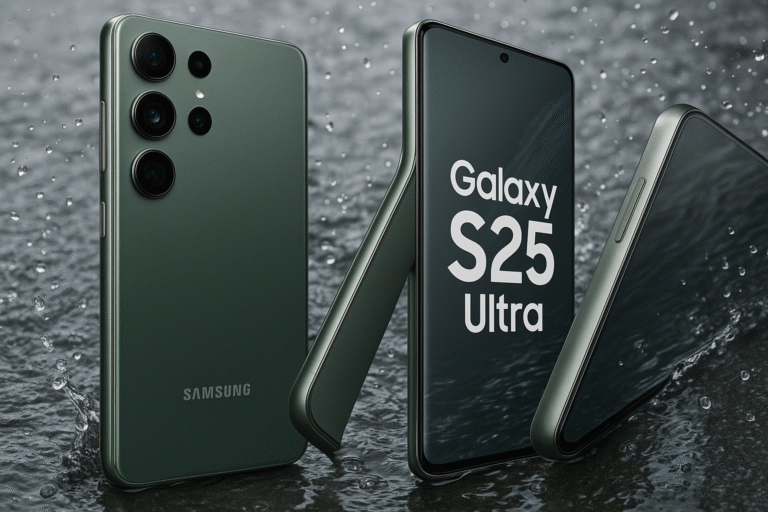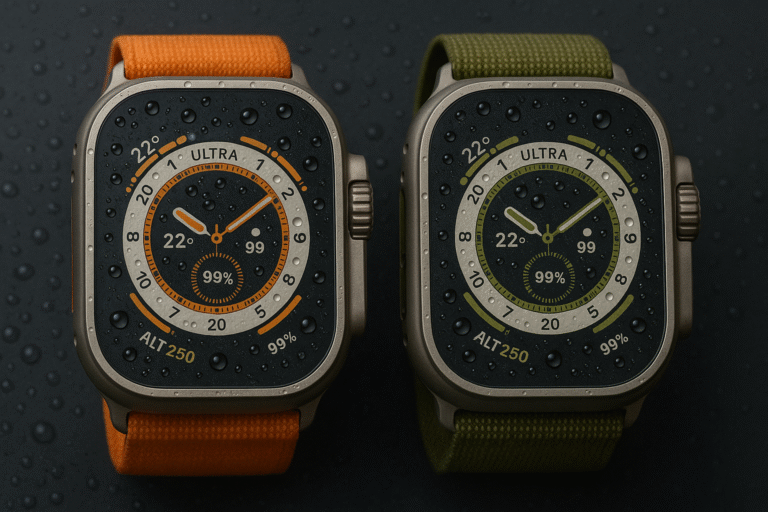Chromebook vs Windows Laptop – Discover Which is Better for Students in 2025 ?
Introduction
Choosing the right laptop for school is an important decision for any student. With so many options available, two of the most popular choices are the Chromebook and the Windows laptop. Both are designed to help students stay productive, but they differ significantly in features, performance, and price.
This blog post explores the key differences between Chromebooks and Windows laptops to help you decide which one suits your academic needs best. Whether you’re a high schooler attending virtual classes or a college student managing assignments and projects, understanding what each device offers is essential.
Why Choosing the Right Laptop Matters for Students
In today’s digital learning environment, choosing the right laptop matters for students more than ever. Whether it’s attending online classes, completing assignments, or collaborating on group projects, a reliable laptop is essential to academic success.
1. Enhances Productivity
A laptop that suits a student’s needs ensures smooth multitasking. Fast processors, enough RAM, and sufficient storage make running multiple applications effortless, saving time and reducing frustration.
2. Supports Specific Academic Programs
Different fields of study require different specifications. For instance, engineering students might need powerful laptops with advanced graphics, while those in liberal arts may need basic models for writing and research. Choosing the right laptop ensures compatibility with required software.
3. Offers Portability and Battery Life
Students often move between classrooms, libraries, and cafes. A lightweight laptop with long battery life helps maintain flexibility and minimizes the need to carry chargers or search for outlets constantly.
4. Reduces Long-Term Costs
Investing in the right laptop from the start can prevent the need for frequent upgrades or repairs. A durable and efficient device provides better value and lasts throughout the academic journey.
5. Improves Learning Experience
Smooth video playback, quick web browsing, and reliable connectivity all contribute to a better learning experience. When students don’t have to worry about tech issues, they can focus on learning.
What is a Chromebook?
A Chromebook is a type of laptop that runs on Chrome OS, a lightweight operating system developed by Google. Unlike traditional laptops that rely heavily on installed software, a Chromebook is built for working in the cloud. It uses web-based apps and services, making it ideal for tasks like browsing, writing essays, creating presentations, and collaborating online.
Most Chromebooks come with limited internal storage because they encourage saving files to Google Drive. They start up quickly, offer long battery life, and are easy to use — features that make them especially popular among students and schools.
Since a Chromebook is tightly integrated with Google tools like Google Docs, Gmail, and Google Classroom, it’s a perfect fit for students who primarily work online and need a simple, reliable device.
As more schools adopt digital learning tools, many are turning to Chromebooks. Understanding Chrome OS and its benefits for students can help parents, teachers, and students make smarter decisions when choosing educational devices.
What is Chrome OS?
Chrome OS is a lightweight, cloud-based operating system developed by Google. It powers Chromebooks and is designed to be fast, secure, and simple. Unlike traditional systems, Chrome OS relies heavily on web applications and cloud storage rather than installed software.
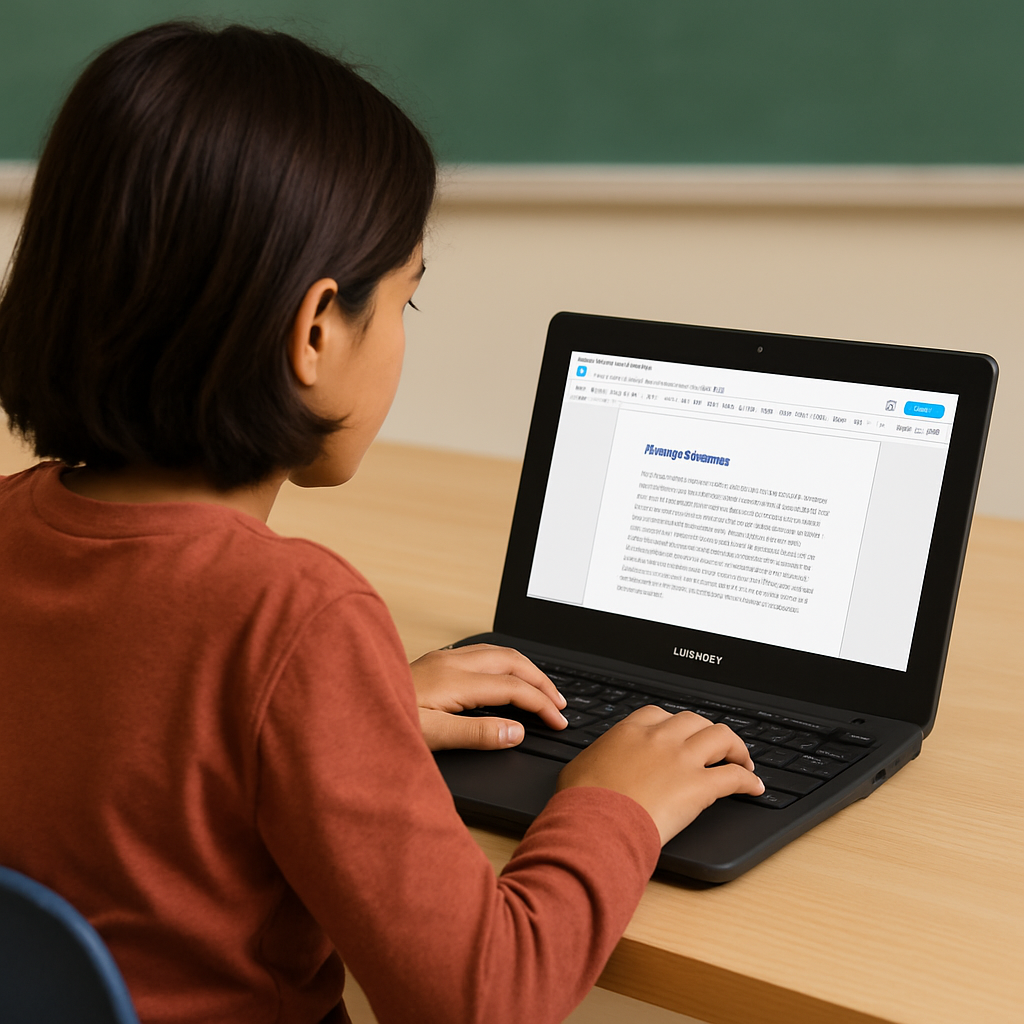
Benefits of Chrome OS for Students
1. Fast and Easy to Use
Chrome OS boots up in seconds and has a clean, minimal interface that’s easy to navigate. Students can quickly get to their assignments and focus on learning without unnecessary distractions.
2. Affordable Devices
Chromebooks tend to be more budget-friendly than Windows or macOS laptops. Schools and families can get high-performing devices at a lower cost, making technology more accessible to more students.
3. Cloud-Based Convenience
With Google Drive integration, students can save and access files online from any device. This means no lost homework, and collaboration with classmates becomes simple and efficient.
4. Long Battery Life
Most Chromebooks offer excellent battery life—often lasting 10 hours or more. Students can get through a full school day without needing to recharge.
5. Automatic Updates and Security
Chrome OS updates automatically in the background and includes built-in virus protection. This reduces the need for IT support and keeps student devices safe from common online threats.
6. Ideal for Google Workspace
Since Chrome OS is designed around Google’s ecosystem, it works seamlessly with apps like Google Docs, Sheets, Slides, and Classroom—tools commonly used in modern education.
When choosing a device for students, Chromebooks stand out for their simplicity and efficiency. Understanding the key features of a Chromebook for school use helps ensure you get a model that meets educational needs and fits the classroom environment.
1. Fast Boot-Up and Performance
Chromebooks are known for quick startup times and smooth performance. Most models boot up in under 10 seconds, allowing students to get to work quickly without delays.
2. Long Battery Life
One of the most important key features of a Chromebook for school use is long-lasting battery life. Many Chromebooks can run for 10–12 hours on a single charge—perfect for a full day of school without needing to plug in.
3. Lightweight and Portable
Designed with students in mind, Chromebooks are typically slim and lightweight. This makes them easy to carry between classes, libraries, and home.
4. Easy Access to Google Workspace
Chromebooks integrate seamlessly with Google Workspace tools like Docs, Slides, and Classroom. These tools are widely used in schools for assignments, collaboration, and communication.
5. Automatic Updates and Built-in Security
Chrome OS handles updates in the background and includes built-in virus protection. This means students are always running the latest version without the need for manual updates or third-party antivirus software.
6. Durable Design Options
Some Chromebook models are built with school environments in mind. They feature rugged designs, spill-resistant keyboards, and reinforced frames to withstand everyday use by students.
7. Affordable Pricing
Compared to traditional laptops, Chromebooks offer excellent value for money. Schools and families can provide reliable technology to students without exceeding their budget.
What is a Windows Laptop?
A Windows laptop is a portable computer that runs on Microsoft Windows, the most widely used operating system in the world. Unlike a Chromebook, a Windows laptop can run a wide range of software, from basic productivity tools like Microsoft Word and Excel to more advanced programs like Adobe Photoshop, AutoCAD, and coding environments.
Windows laptops come in many shapes, sizes, and price ranges — from budget-friendly options to powerful machines built for gaming or professional use. This flexibility makes them suitable for students in all fields, especially those studying subjects that require specialized software.
Because Windows supports both online and offline applications, students can work without needing a constant internet connection — something that gives it an edge over cloud-focused devices like the Chromebook.
With so many laptop choices available, it’s important to understand how Windows laptops differ from Chromebooks—especially when selecting the right device for school or home use. While both serve the same basic functions, they operate very differently in terms of software, features, and usage.
1. Operating System
The main difference lies in the operating system. Windows laptops run Microsoft’s Windows OS, which supports a wide range of software. Chromebooks run on Chrome OS, a cloud-based system designed for speed and simplicity, mainly using web apps and Google services.
2. Software Compatibility
Windows laptops can install and run traditional desktop software like Microsoft Office, Adobe Creative Suite, and many others. Chromebooks mostly rely on web apps and Android apps from the Google Play Store. This means Chromebooks are more limited in terms of advanced or specialized software.
3. Storage
Windows laptops typically offer larger internal storage, ranging from 256GB to 1TB or more. Chromebooks often come with 32GB to 128GB of storage, but are designed to store files in the cloud via Google Drive.
4. Performance Needs
Because Windows handles more complex tasks and apps, these laptops generally require more powerful hardware. Chromebooks, by contrast, are lightweight and run efficiently on less powerful components, making them faster for basic tasks like browsing and document editing.
5. Security and Updates
Chrome OS is designed with built-in security and automatic updates that run in the background, reducing the risk of viruses. Windows laptops offer security as well but often require third-party antivirus software and manual updates.
6. Price
One of the biggest differences is cost. Chromebooks are generally more affordable, making them ideal for students or basic users. Windows laptops come in a wider range of prices, especially for those needing higher performance or specific software.
Conclusion
How Windows laptops differ from Chromebooks comes down to operating system, software capabilities, storage, and price. If you need flexibility and power for a wide range of tasks, a Windows laptop may be the better choice. If you prefer simplicity, affordability, and cloud-based work, a Chromebook is a smart option.
Chromebook vs Windows Laptop – A Student’s Perspective
When comparing a Chromebook and a Windows laptop, it’s important to look at how each device performs in a student’s daily routine. Students need a laptop that is reliable, fast, and compatible with school tasks. Below is a side-by-side breakdown of key features that matter most to students.
| Feature | Chromebook | Windows Laptop |
|---|---|---|
| Price | Affordable; great value for tight budgets | Varies; some low-cost options, but can be expensive |
| Speed & Boot Time | Boots up in seconds; very responsive | Can be slower depending on the model |
| Battery Life | Long-lasting (often 10+ hours) | Moderate (5–10 hours depending on usage) |
| Software Support | Runs web-based apps like Google Docs & Classroom | Supports full desktop apps like MS Office & Adobe |
| Storage | Cloud-based with limited local storage | Larger local storage available |
| Ease of Use | Simple and user-friendly | More complex but very customizable |
| Offline Access | Limited without internet | Full offline functionality |
| Best For | Note-taking, browsing, online assignments | Multimedia projects, gaming, advanced software |
For students who rely mostly on the internet, Google tools, and basic schoolwork, a Chromebook is more than capable. However, students in fields like graphic design, programming, or engineering might need the broader software support a Windows laptop provides.
Chromebook: Ideal for Basic Schoolwork
A Chromebook is designed to be simple, fast, and efficient. For students who mostly use their laptops for tasks like note-taking, researching online, and completing assignments in Google Docs or Google Classroom, the Chromebook is a great choice. Its fast boot-up times and long battery life make it ideal for students who are always on the go. Since it runs on Chrome OS, it’s built to work seamlessly with Google’s cloud-based services, ensuring easy access to everything students need in their academic life.
- Pros for Students:
- Fast, responsive, and simple to use
- Affordable, making it accessible for students on a budget
- Excellent battery life (often 10-12 hours)
- Best suited for cloud-based tasks, such as writing essays, research, and virtual classroom participation
- Cons for Students:
- Limited offline capabilities (although some apps work offline)
- Cannot run full desktop applications like Adobe or AutoCAD
Windows Laptop: Best for Diverse, Demanding Tasks
A Windows laptop, on the other hand, is a more versatile option that can handle a wider variety of tasks. While a Chromebook excels at web-based work, a Windows laptop offers the flexibility to run a range of desktop applications. This is especially important for students in fields like graphic design, engineering, video editing, or computer science, where specialized software is necessary. Additionally, Windows laptops tend to have larger storage options, powerful processors, and are available in a wider range of prices and configurations.
- Pros for Students:
- Can run specialized software such as Microsoft Office, Adobe Creative Suite, and many programming tools
- Greater flexibility and customization in terms of hardware and storage
- Supports both online and offline tasks
- Better for gaming or multimedia work
- Cons for Students:
- Generally more expensive than Chromebooks
- Shorter battery life (5-8 hours on average)
- Can be bulkier and more complex for students who only need basic features
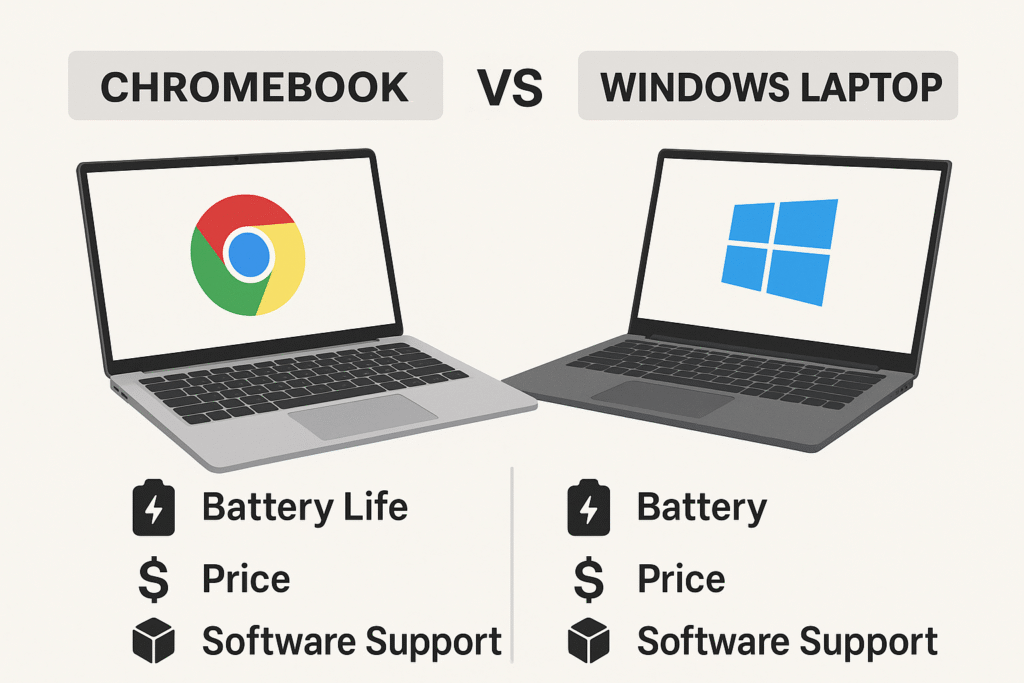
Which Is Better for Students in 2025?
As we move further into 2025, the decision between a Chromebook and a Windows laptop becomes even more relevant. The ideal choice depends on the student’s needs, course requirements, and budget. Here’s a breakdown of which device might suit different types of students.
Choose a Chromebook if:
- You primarily use Google tools: If you rely on Google Docs, Sheets, and Classroom for assignments and collaboration, a Chromebook is a great fit. The seamless integration with these apps ensures smooth and efficient workflow.
- You need a budget-friendly option: Chromebooks are generally more affordable, making them perfect for students on a tight budget who only need basic functionality like browsing, note-taking, and research.
- You prioritize battery life: If you’re often on the go, attending lectures or studying in different places, the extended battery life of a Chromebook (up to 12 hours or more) is a huge advantage.
- You work mostly online: Students whose tasks mostly involve online research, social media, or cloud-based work will find a Chromebook fast and convenient.
Choose a Windows Laptop if:
- You require specialized software: For students in fields like graphic design, computer science, or video editing, a Windows laptop will give you access to powerful software that a Chromebook simply can’t support.
- You need offline capabilities: Windows laptops run full desktop applications that don’t require an internet connection, which is helpful for tasks like programming or using heavy-duty software.
- You want more flexibility: A Windows laptop offers a variety of options in terms of performance, customization, and storage, making it a better choice for students with diverse academic needs.
Final Verdict: Chromebook vs Windows Laptop for Students
After considering the key features and differences between a Chromebook and a Windows laptop, the best choice for students really depends on their individual needs, budget, and academic requirements.
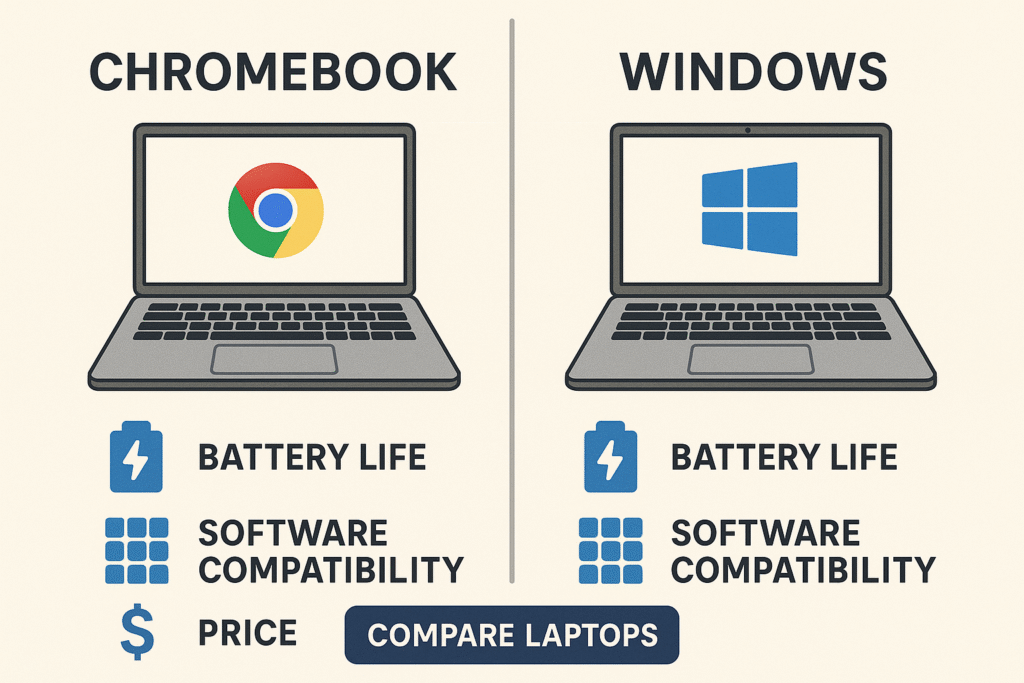
Choose a Chromebook if:
- You need an affordable, easy-to-use device: If you’re on a budget and need a straightforward laptop for tasks like writing papers, browsing, and using Google Classroom, a Chromebook offers great value.
- You mostly use cloud-based tools: If your school relies on Google tools like Google Docs, Sheets, and Drive, a Chromebook integrates perfectly with this ecosystem, making it an ideal choice.
- Battery life is a priority: With Chromebooks offering up to 12 hours of battery life, it’s perfect for long school days or studying on the go.
- You value simplicity and speed: Chromebooks are designed to be quick and user-friendly, making them ideal for students who need a hassle-free device for everyday school tasks.
Choose a Windows Laptop if:
- You need powerful software and offline access: If your studies require specialized software such as Adobe Creative Suite, AutoCAD, or programming tools, a Windows laptop is essential. It also gives you the flexibility to work offline with full desktop applications.
- You need a more customizable device: Windows laptops come in a variety of models and configurations, offering more storage, processing power, and even gaming capabilities, making them a better choice for students in demanding fields.
- You’re willing to invest in a higher price: While Windows laptops tend to be more expensive, the added functionality, versatility, and software compatibility can make them worth the investment for certain fields of study.
Call to Action
Now that you know the key differences between a Chromebook and a Windows laptop, it’s time to choose the best device for your needs. Whether you’re a student looking for a budget-friendly, cloud-focused laptop or someone who needs more power and software compatibility, you have the information you need to make an informed decision.
If you’re still unsure which laptop is right for you, feel free to leave a comment below with any questions. Our team is here to help you find the perfect fit for your academic needs. Don’t forget to share this post with fellow students who might be facing the same decision!
Are you ready to get started on your laptop journey? Browse through our recommendations and find the best Chromebook or Windows laptop for your school year!
Conclusion
Choosing between a Chromebook and a Windows laptop ultimately comes down to your specific needs as a student. If you’re looking for an affordable, lightweight device with great battery life for basic tasks like note-taking, web browsing, and using Google tools, a Chromebook is an excellent choice. On the other hand, if you require powerful software, more storage, and flexibility for tasks like graphic design, programming, or multimedia work, a Windows laptop might be the better option.
Both devices have their advantages, so consider how you plan to use your laptop, your budget, and the software you need. By understanding the strengths and limitations of each device, you’ll be able to make an informed decision that will support your academic success for years to come.
if you need further explanation contact us
read more posts by blog page
read more from Google Chrome

